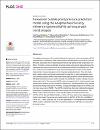On the Error Performance of Non-orthogonal Multiple Access Systems
| المؤلف | Almohamad A. |
| المؤلف | Althunibat S. |
| المؤلف | Hasna , Mazen |
| المؤلف | Qaraqe K. |
| تاريخ الإتاحة | 2022-04-26T11:06:45Z |
| تاريخ النشر | 2020 |
| اسم المنشور | International Conference on ICT Convergence |
| المصدر | Scopus |
| المعرّف | http://dx.doi.org/10.1109/ICTC49870.2020.9289229 |
| الملخص | Unlike orthogonal multiple access schemes, non-orthogonal (NOMA) ones have arisen as an appealing solution to meet the requirements of the upcoming era of massive connectivity. In NOMA schemes, users are allowed to restrainedly interfere. Therefore, NOMA's ability to serve a number of users more than the number of available orthogonal channels has attracted tremendous research efforts in its different performance aspects. However, its error rate performance has not been sufficiently addressed yet. The currently available derived bit error rate (BER) formulas are either assuming ordered users based on their instantaneous channel gains or fit for special cases only. In this paper, assuming that the users are ordered in terms of the average channel gain and considering arbitrary number of users and modulation order, the average pairwise error probability (PEP) of downlink NOMA systems under Nakagami-m fading channels is derived. Both detection rules, maximum likelihood and successive interference cancellation, have been considered. The derived average PEP is then used to obtain the asymptotic diversity gain and an upper bound on BER using union bounding technique. Simulation results validate the accuracy of the derived formulas over different setups. |
| راعي المشروع | Qatar National Research Fund |
| اللغة | en |
| الناشر | IEEE Computer Society |
| الموضوع | Block codes Errors Fading channels Maximum likelihood Trellis codes Bounding techniques Error rate performance Multiple access scheme Multiple access systems Nakagami-m fading channels Orthogonal channels Pair-wise error probability Successive interference cancellations Bit error rate |
| النوع | Conference |
| الصفحات | 116-121 |
| رقم المجلد | 2020-October |
الملفات في هذه التسجيلة
| الملفات | الحجم | الصيغة | العرض |
|---|---|---|---|
|
لا توجد ملفات لها صلة بهذه التسجيلة. |
|||
هذه التسجيلة تظهر في المجموعات التالية
-
الهندسة الكهربائية [2849 items ]


